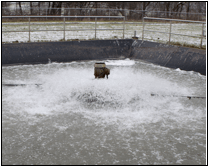
In a previous blog, Is Your Wastewater Lagoon Ready for Winter? Prepping for Cold Temperatures, we described the effect of cold temperatures on biological processes. In this article, we’ll discuss the downside of lagoon surface aerators, which are particularly vulnerable to freezing temperatures.
Types of Lagoon Surface Aerator
- Horizontal Aspirator: This type of wastewater lagoon surface aerator has a motor aligned horizontally at an angle of 45 degrees or more. A hollow shaft with a propeller tip connects to the motor and rotates on ball bearings. Aeration of the water occurs below the surface of the water as the motor rotates the propeller and air is pushed down the shaft and into the basin where it is turbulently churned into the water.
Vertical “Splash” Aerator: This surface aerator gets its name from its vertically aligned motor. A propeller at the bottom of the motor spins and draws water from underneath the unit, and then launches it into the air in a circular pattern. Water aeration occurs above the surface as the small droplets of water fall back to the basin; the large collective surface area of the droplets allows for contact between water and ambient air, facilitating oxygen transfer.
- “Jet” Surface Aerator: This brand of surface aerator is essentially a hybrid of the vertical and horizontal aerators. Like the horizontal aerator, its motor is located off-axis and aeration is achieved via drafted air or injected with a blower. Like a vertical aerator, water is drawn from a propeller and expelled across the surface, using the droplet-to-air contact to transfer additional oxygen.
What all these lagoon surface aerators have in common is that mechanical components are in the water, and therefore susceptible to freezing and clogging. Following are the drawbacks to the lagoon surface aerator:
- High Maintenance Requirements – Lagoon surface aerators rely on constantly moving motors on the surface of the water to operate properly. As a result, the potential for breakdown increases. For this reason, mechanical aerators have a much higher malfunction rate than other systems. It is recommended that each surface aerator be serviced biannually. Given that wastewater lagoons typically use five to ten surface aerators and they can only be serviced from a boat, this maintenance job becomes a hassle. Furthermore, by installing a system prone to malfunctioning, you risk excessive facility downtime.
- Inefficient Aeration – Independent testing facilities have shown surface aerators to transfer just 1.25–2.50 pounds of oxygen per horsepower hour. This is compared to diffused aeration systems, which can impart as much as 6–7 lb/hp-h. As a result, surface aerators have higher power requirements and cost more to run.
- Limited Mixing Performance – A surface aerator can really only mix the water in its immediate vicinity. Treatment is generally completed by only a few surface aerators per wastewater lagoon. As a result, “dead zones” tend to develop where water stagnates and sludge accumulates. The only way to increase mixing is to add additional aerators at an increased capital and operational cost. Our video case study of the Lakewood treatment facility in Lake Odessa, MI, illustrates the importance of lagoon mixing and the inadequacy of surface aerators.
- Ineffective in Deep Water – Since the aeration takes place on the surface, the deeper water columns see little to no treatment. This allows solids to accumulate, virtually untouched by the aerator. The addition of draft tubes can help some, but even so the area of influence is very limited horizontally across the surface.
- Trouble in Cold Weather – In cold temperatures, water churned up by a lagoon surface
aerator freezes when it is exposed to ambient air. The combination of splashing water and being exposed to freezing rain and snow makes these motors prone to failure in cold weather. Because of this propensity to self destruct, some northern states have banned the use of mechanical surface aeration in new plants.
While there are some benefits to surface aerators, namely their ease of installation and resistance to caustic chemicals and surfactants, their unreliability and inefficiency make them a poor choice, especially in colder climates.
Reliable Lagoon Aeration: Triplepoint’s Ares Aerator®
Triplepoint developed the Ares lagoon aerator to harness the benefits of the various existing technologies while eliminating their drawbacks. Ares combines fine bubble diffusers for superior oxygen transfer efficiency with a coarse bubble static tube to provide robust mixing in a single portable unit.
Unlike surface aerators, Ares has no moving parts in the water to freeze, break, and malfunction. Each self-weighted Ares unit is attached to an on-shore blower via flexible weighted tubing, then simply lowered into the water. Maintenance can be completed from the surface with no system downtime. And because it’s modular, the Ares system can be scaled to meet treatment needs.


 Vertical “Splash” Aerator: This surface aerator gets its name from its vertically aligned motor. A propeller at the bottom of the motor spins and draws water from underneath the unit, and then launches it into the air in a circular pattern. Water aeration occurs above the surface as the small droplets of water fall back to the basin; the large collective surface area of the droplets allows for contact between water and ambient air, facilitating oxygen transfer.
Vertical “Splash” Aerator: This surface aerator gets its name from its vertically aligned motor. A propeller at the bottom of the motor spins and draws water from underneath the unit, and then launches it into the air in a circular pattern. Water aeration occurs above the surface as the small droplets of water fall back to the basin; the large collective surface area of the droplets allows for contact between water and ambient air, facilitating oxygen transfer.
